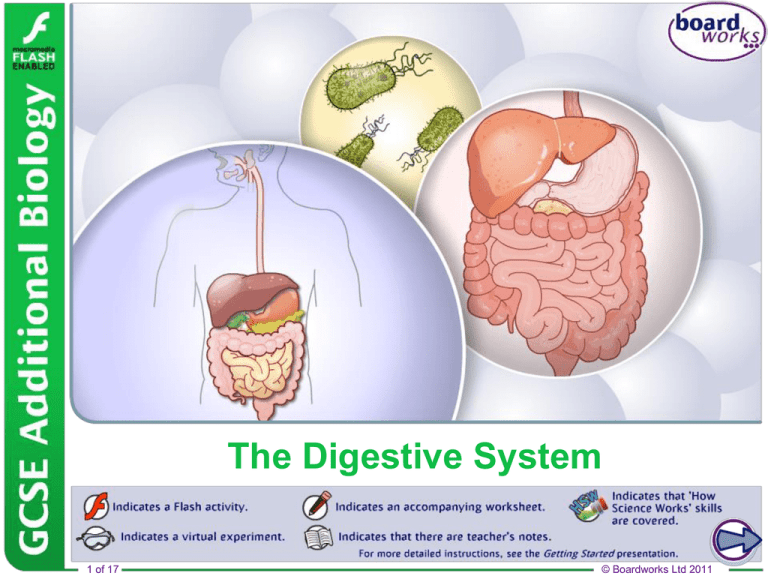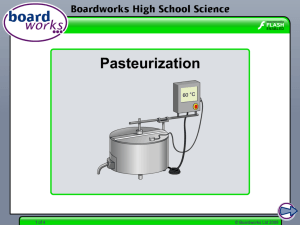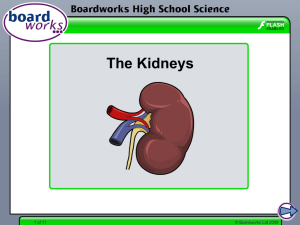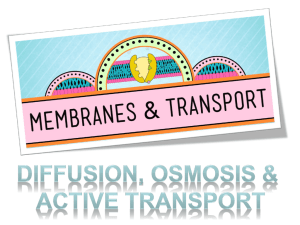The Digestive System
advertisement

The Digestive System 1 of 17 © Boardworks Ltd 2011 Cloning in the media 2 of 17 © Boardworks Ltd 2011 Systems in the body The more complex an organism is, the more organized its cells are. Similar cells are often grouped together to form a tissue, and several of these tissues may form an organ. Organ systems are groups of organs which perform a specific function. In mammals, several systems help to exchange substances with the environment. This includes the exchange of gases in the respiratory system and the exchange of food molecules in the digestive system. 3 of 17 © Boardworks Ltd 2011 The digestive system 4 of 17 © Boardworks Ltd 2011 Digestive functions 5 of 17 © Boardworks Ltd 2011 Peristalsis 6 of 17 © Boardworks Ltd 2011 7 of 17 © Boardworks Ltd 2011 Diffusion 8 of 17 © Boardworks Ltd 2011 Diffusion and digestion Carbohydrates, proteins and fats are made up of large molecules that cannot be readily absorbed by the body. Digestion breaks down large food molecules into smaller molecules such as glucose, amino acids and fatty acids that can be easily absorbed. In which part of the digestive system is most food absorbed? Small food molecules are usually absorbed in the small intestine, diffusing across the intestine wall and into the bloodstream. 9 of 17 © Boardworks Ltd 2011 How is the small intestine adapted? The wall of the small intestine is lined with many tiny fingerlike projections called villi. These are very thin (as little as one cell thick) and increase the surface area of the small intestine, both of which increase the speed of diffusion. villus capillary network small intestine blood vessels 10 of 17 © Boardworks Ltd 2011 Diffusion and the small intestine The villi have a good network of capillaries. Digested food molecules are absorbed into the blood to be taken elsewhere in the body. How does this happen? The concentration of dissolved food molecules is higher in the small intestine than in the blood entering the villus. This means that the dissolved food molecules diffuse from the small intestine into the blood, moving from higher to lower concentration. 11 of 17 glucose © Boardworks Ltd 2011 12 of 17 © Boardworks Ltd 2011 Friendly bacteria Some people believe that having high numbers of certain ‘friendly’ bacteria (or probiotics) in the intestines can improve health. The numbers of ‘friendly’ bacteria can be increased by: taking probiotic tablets containing bacteria, such as Bifidobacteria and lactic acid bacteria (Lactobacillus) eating the sugars that these bacteria feed on. These are called prebiotic oligosaccharides and are found in oats, chicory, bananas, garlic and onions. Prebiotics and probiotics are claimed to improve digestion, prevent colon cancer, reduce cholesterol and blood pressure, and improve immune function. What is the evidence for these claims? 13 of 17 © Boardworks Ltd 2011 Lowering cholesterol Plant stanol esters are claimed to reduce levels of lowdensity cholesterol in the blood. High levels of cholesterol can lead to cardiovascular diseases. In 1999, a study compared the decrease in cholesterol levels between people on a low-cholesterol diet only, and people who ate the same diet and also ate plant sterol esters. patient diet reduction in cholesterol special diet alone 7.7% special diet and plant stanol esters 18.3% What do these results suggest? What more would you need to know about the study to draw a firm conclusion? 14 of 17 © Boardworks Ltd 2011 15 of 17 © Boardworks Ltd 2011 Glossary 16 of 17 © Boardworks Ltd 2011 Multiple-choice quiz 17 of 17 © Boardworks Ltd 2011





![Direction_and_Scale[1]](http://s2.studylib.net/store/data/005432475_1-80ce3065f13008250a8cdec135db9846-300x300.png)




